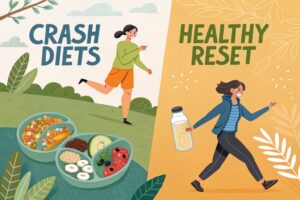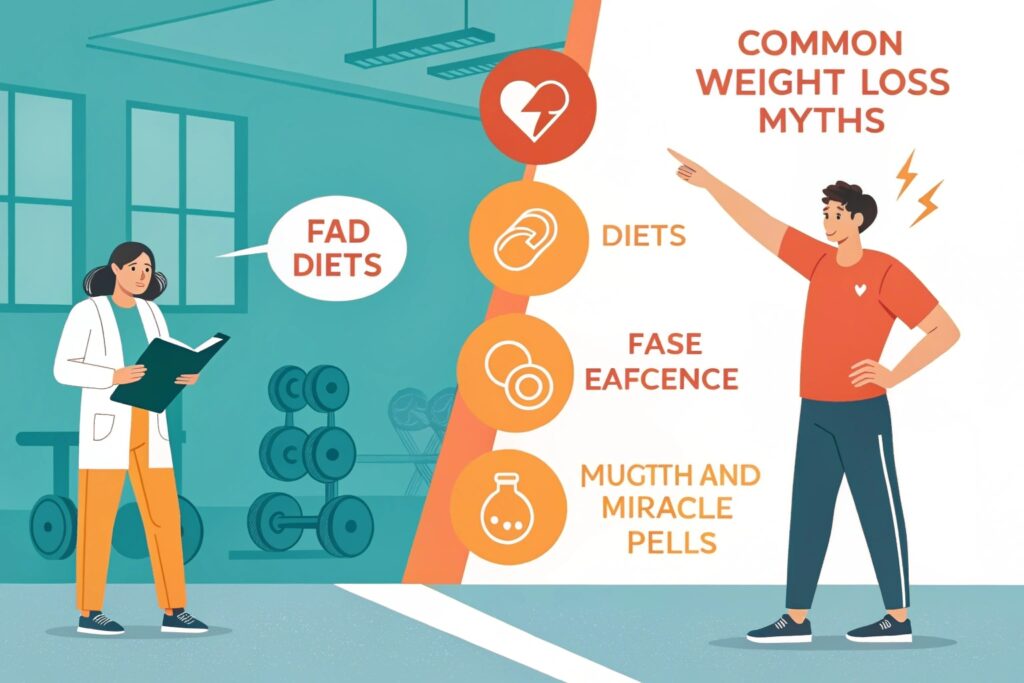Debunking Myths: What New Weight‑ Lossers Need to Stop Believing
Introduction
Embarking on a weight‑loss journey can feel like stepping into a maze of conflicting advice, glossy ads, and well‑meaning—but often misguided—friends. Debunking Myths: What New Weight‑Lossers Need to Stop Believing is essential not only for staying motivated but also for protecting your health and avoiding wasted effort. In the next 1,200‑plus words, we’ll separate fact from fiction, draw on peer‑reviewed research, and give you actionable, science‑backed strategies that work for beginners and seasoned dieters alike. By the end, you’ll know which “quick fixes” are pure hype, which old‑fashioned rules still hold water, and exactly how to apply sustainable principles to reach your goals safely and confidently.
Myth‑Driven Frustration Is a Real Barrier
A 2022 survey by the National Weight Control Registry found that 78 % of newly‑started dieters reported quitting within the first three months because expectations didn’t match reality. The gap between myth‑based expectations and actual physiological responses creates a psychological toll that can trigger “all‑or‑nothing” thinking. For instance, many new weight‑lossers cling to the idea that “all calories are created equal,” ignoring how hormone‑driven hunger, gut microbiota, and metabolic adaptation shape how those calories are processed. When a diet feels impossible, the brain’s reward‑center releases cortisol, which can actually increase abdominal fat storage (Harvard Health Publishing, 2021). Recognising the emotional weight of myths helps you replace self‑defeat with evidence‑based confidence.
Section 2 – Myth #1: “Carbs Are the Enemy”
Carbohydrates have been unfairly demonised since the low‑carb craze of the early 2000s, yet they remain the body’s primary fuel source. A randomized controlled trial published in The New England Journal of Harvard (2020) demonstrated that participants on a moderate‑carb, high‑protein diet lost 2‑3 % more body fat over 12 weeks than those on a strict low‑carb plan, primarily because they could sustain a higher total calorie deficit without the hunger spikes that often accompany severe carb restriction. Complex carbs—whole grains, legumes, fruits, and vegetables—provide essential micronutrients, fiber, and a steady release of glucose that supports stable insulin levels, reducing cravings.
To put this into practice, replace refined grains (white bread, sugary cereals) with high‑fiber alternatives like quinoa, oats, or brown rice. A simple rule of thumb: aim for at least 25 g of fiber per day (American Heart Association). Track your intake using a free app such as MyFitnessPal, which flags refined‑carb‑heavy meals and suggests higher‑fiber swaps. By reframing carbs as allies rather than foes, you’ll preserve muscle glycogen, keep energy levels steady, and avoid the metabolic slowdown that often follows overly restrictive diets.
Section 3 – Myth #2: “You Must Cut All Fat to Lose Weight”
Fat is essential for hormone production, including leptin and estrogen, which regulate appetite and metabolism. Cutting dietary fat below 15 % of total calories can impair satiety signals, leading to overeating later in the day. A meta‑analysis of 31 studies (Journal of Nutrition, 2021) found that moderate‑fat diets (30‑35 % of calories) outperform low‑fat diets in preserving lean body mass while still promoting fat loss. Moreover, the type of fat matters: monounsaturated (olive oil, avocados) and polyunsaturated fats (fatty fish, walnuts) support cardiovascular health and reduce inflammation—a key factor in insulin resistance.
Actionable tip: Incorporate one serving of omega‑3‑rich fish (e.g., salmon, sardines) twice weekly, or use a tablespoon of flaxseed oil in salads. Replace butter with extra‑virgin olive oil for cooking at medium heat; it retains its beneficial properties and adds a satisfying mouthfeel that curbs cravings. Tracking dietary fat through a nutrition journal helps you stay within the recommended 20‑35 % range, ensuring you reap the hormonal benefits while still creating a calorie deficit.
Section 4 – Myth #3: “

Detox teas, juice fasts, and 24‑hour “cleanse” programs promise rapid results but typically strip the body of calories, electrolytes, and essential nutrients. The National Institutes of Health warns that prolonged fasting can trigger muscle catabolism, lower basal metabolic rate (BMR), and cause electrolyte imbalances that may lead to dizziness or cardiac arrhythmias. A 2023 review in Obesity Reviews concluded that short‑term fasting does not result in greater fat loss than a sustained moderate calorie deficit, and any weight lost is mostly water weight, not adipose tissue.
Instead of a crash cleanse, adopt a gentle “reset” that focuses on whole foods, adequate hydration, and balanced macronutrients. For example, a 3‑day “clean eating” plan that includes lean protein (chicken breast, tofu), plenty of non‑starchy vegetables, and a modest portion of complex carbs can reboot digestion without compromising metabolic health. Pair this with 2‑liters of water daily and a 30‑minute walk to sustain circulation and promote lymphatic drainage—healthy habits that support long‑term fat loss better than any “detox” hype.
Section 5 – Myth #4: “All Calories Count the Same, So Portion Control Isn’t Necessary”
While a calorie is technically a unit of energy, the thermic effect of food (TEF)—the energy required to digest, absorb, and store nutrients—varies widely among macronutrients. Protein has a TEF of 20‑30 %, meaning 100 kcal of protein actually yields only 70‑80 kcal net for the body. Fat’s TEF is roughly 0‑3 %, and carbs sit at 5‑10 %. Consequently, a 150‑kcal serving of grilled chicken will affect your energy balance differently than a 150‑kcal serving of cheese. Ignoring these nuances can hinder weight‑loss efforts, especially when high‑protein meals keep you full longer, reducing overall intake.
Practical solution: Prioritise protein at each meal (aim for 0.8‑1.0 g per kg of body weight for non‑athletes) and use portion‑control tools like a kitchen scale or the hand‑method (palm‑size protein, fist‑size carbs, thumb‑size fats). Visual guides help you estimate portions without meticulous counting, maintaining a sustainable deficit while ensuring nutrient adequacy. Real‑world example: swapping a 200‑kcal serving of pasta with a 150‑kcal serving of lentils plus vegetables can cut total calories by 50 % while boosting protein and fiber.
Section 6 – Myth #5: “Weight‑Loss Supplements Are a Shortcut to Success”
The market for “fat‑burners” exceeds $2 billion in the U.S. alone, yet rigorous scientific evidence supporting their efficacy is scant. A systematic review in JAMA Network Open (2022) evaluated 15 over‑the‑counter thermogenic products and found no clinically significant difference in weight loss compared with placebo when diet and exercise were controlled. Moreover, ingredients like ephedra, synephrine, or high‑dose caffeine can cause tachycardia, hypertension, and anxiety, posing serious health risks.
A credible, evidence‑based alternative is green tea extract, which contains catechins that modestly increase energy expenditure (approximately 3‑4 % increase in resting metabolic rate). However, the can be effective only when combined with a balanced diet and regular exercise. Instead of relying on pills, focus on behavioral supplements: a daily multivitamin to fill micronutrient gaps, vitamin D if you’re deficient (linked to weight regulation), and probiotic capsules to support gut health. Use reputable brands that undergo third‑party testing (e.g., USP, NSF).
Putting It All Together – A Step‑by‑Step Action Plan
-
- Assess Your Baseline – Record weight, body‑fat percentage, and measurements. Use a reliable device (e.g., handheld bio‑impedance scale) and log data in a spreadsheet or health app.
-
- Calculate a Sustainable Deficit – Subtract 500–750 kcal from your maintenance calories (estimated via the Mifflin‑St Jeor equation). This yields ~1 lb of loss per week without drastic hunger.
-
- Macronutrient Distribution – Target 30 % protein, 30‑35 % fat, 35‑40 % carbs. Adjust based on personal preference and activity level.
-
- Meal Planning – Prep at least 3 meals/week using a template: protein + veg + complex carb + healthy fat. For example, grilled salmon, quinoa, roasted broccoli, and a drizzle of olive oil.
-
- Movement Integration – Combine 150 minutes of moderate cardio (brisk walking, cycling) with 2‑3 strength sessions per week to preserve lean mass and boost metabolism.
-
- Monitor & Iterate – Review progress every 2 weeks. If weight stalls >2 weeks, adjust calories by -100 kcal, increase protein, or add an extra 10‑minute walk.
Frequently Asked Questions
Q1: Can I still enjoy desserts while losing weight?
Absolutely. Portion control and timing matter. A ½‑cup of Greek‑yogurt topped with berries and a drizzle of honey satisfies sweet cravings while providing protein and fiber, keeping the net calorie impact modest (≈150 kcal).
Q2: How important is sleep for weight loss?
Sleep deprivation raises ghrelin (hunger hormone) and lowers leptin (satiety hormone). A 2021 study in Sleep Medicine linked <6 hours of sleep to a 27 % higher risk of obesity. Aim for 7‑9 hours of quality sleep to support hormonal balance and recovery.
Q3: Should I count calories on an app?
For beginners, tracking provides awareness and accountability. Use reputable apps that have large food databases and automatic nutrient breakdowns. Over time, you’ll develop an intuitive sense of portion sizes and can phase out strict tracking.
Conclusion & Call to Action
By shedding the falsehoods outlined in Debunking Myths: What New Weight‑Lossers Need to Stop Believing, you empower yourself with the science‑backed tools that deliver real, lasting results. Remember: weight loss isn’t a sprint—it’s a marathon built on balanced nutrition, consistent movement, and evidence‑based habits.
If you found this guide helpful, share it with friends embarking on their own journeys, leave a comment with the myth that surprised you the most, and explore our related articles on sustainable diet plans and mindset coaching. Together, let’s create a community where accurate information triumphs over hype, and every new weight‑losser feels confident, informed, and ready to succeed.



